
by Abbey Smith | Jul 3, 2024
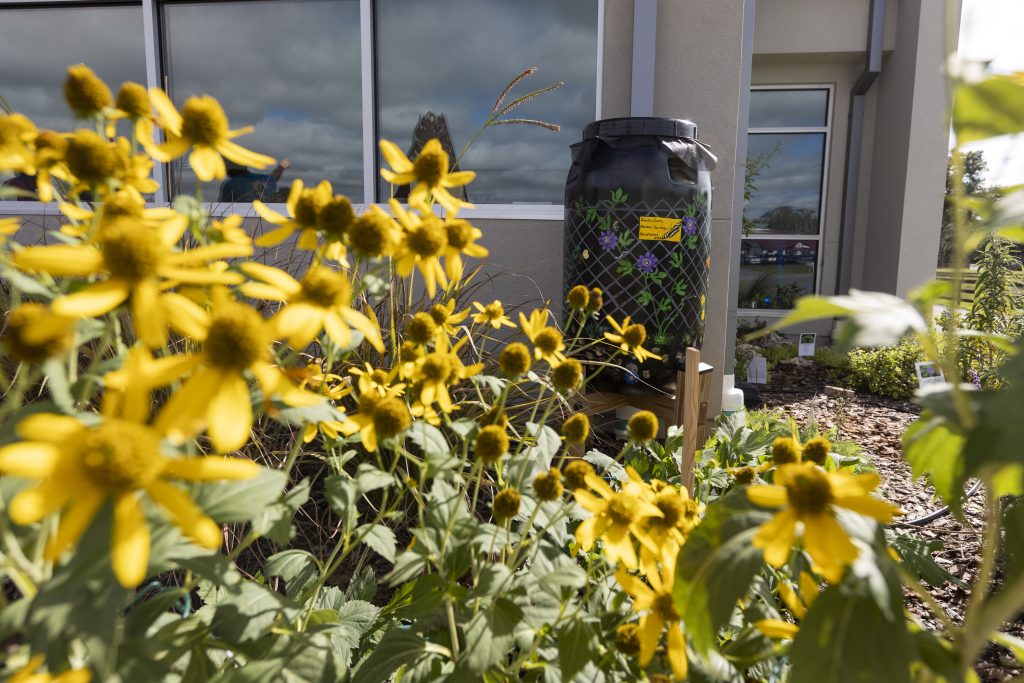
Rain barrel at the teaching demonstration gardens at the Alachua County Extension Office. Photo Credit: Tyler Jones, UF/IFAS
Water is one of the most valuable natural resources and with the ever growing concern of climate change and the hot dry conditions Northwest Florida has already experienced this summer, every drop counts. One way you could combat this issue is by installing a rain barrel at your home. By having a rain barrel on hand, you can reduce stormwater runoff, potentially save money, and improve the health of your plants. Here’s what you need to know:
What is a rain barrel? A rain barrel is a container or storage tank that collects runoff water from a catchment area (a rooftop). They are typically placed under downspouts and capture the water runoff from your home’s gutters. The type of container used to make a rain barrel could be any type, but it cannot have stored chemicals prior to its use as a rain barrel.
Now that we know the definition, why exactly do people use rain barrels? For one, they aid in water conservation. Rain barrels help reduce the amount of potable water used for outdoor purposes, which is important during dry weather spells and areas known for drought conditions. There are also potential cost savings with using a rain barrel. By using the collected rainwater for watering your garden, cleaning outdoor surfaces, or even washing your car, homeowners could potentially reduce their water bills significantly. Having a rain barrel is also a Florida-Friendly way to gardening. Rain barrel usage co-aligns with the Florida-Friendly Landscaping Principles #2: Water Efficiently and #8: Reduce Stormwater Runoff. The use of rain barrels also aligns with sustainable living. It reduces the reliance on municipal water systems and promotes awareness of water usage and conservation.
To install a rain barrel, you will need to obtain a container or “barrel” that is several gallons large to store the water. You can purchase or make one yourself! It will need a secure lid to prevent debris and insects from getting inside. The barrel will need to be placed under a downspout from your home’s roof gutter systems. The ground will need to be level and the barrel could possibly need to be elevated to make accessing the water easier. Once you have placed the rain barrel in the location you want it, you will need to install a rainwater diverter on your downspout. This will help channel the rainwater into the barrel and can be adjusted once the barrel has become full of water. You will also want to install a spigot near the bottom of the rain barrel to access the water and an overflow valve of some sort. The overflow valve will help redirect excess water away from your foundation when the rain barrel becomes full. Maintenance of a rain barrel is generally very low but you need to check regularly for debris in the water and ensure all the mechanisms are functioning like they should be.
How can you use the water collected in a rain barrel? The most obvious answer would be to water your garden and outdoor plants. Rainwater is perfect for watering the lawn, your flowers, and vegetable gardens. The water quality of collected rainwater is often more beneficial for plants as it is non-chlorinated water. Rainwater is also great for indoor plants too as it decreases the amount of mineral build-up that can occur from using tap water.
By installing a rain barrel at your home, you are taking a small leap with significant environmental impact. It is an easy, cost-effective way to reduce your utility bills, conserve water, and contribute to sustainable living. For more information on rain barrels and how to install one, please visit:
https://ffl.ifas.ufl.edu/ffl-and-you/home-landscapes/diy/rain-barrels/
https://sfyl.ifas.ufl.edu/lawn-and-garden/saving-and-using-rainwater/
https://blogs.ifas.ufl.edu/browardco/2019/07/01/florida-friendly-landscaping-adopting-water-conservation-practices-with-rain-barrels/
*This article was written with the aid of ChatGPT AI Services.*
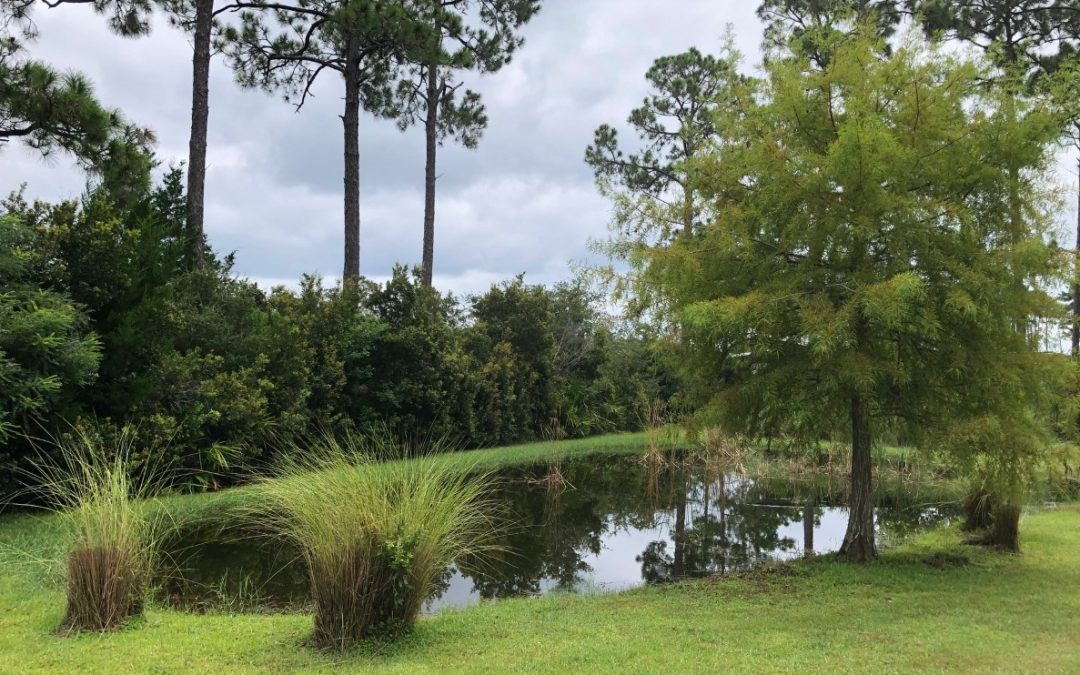
by Stephen Greer | Aug 11, 2021
One big goal of establishing a home lawn and landscape is to enjoy an attractive setting for family and friends, while also helping manage healthy soils and plants. Soil compaction at these sites can cause multiple problems for quality plants establishment and growth. Soil is an incredibly important resource creating the foundation for plants and water absorption.
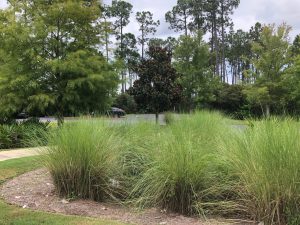
Photo courtesy: Stephen Greer, UF IFAS
Soils are composed of many different things, including minerals. In Florida, these minerals often include sand of differing sizes and clay in the northern area of the counties in the panhandle of Florida. Soil is also composed of organic matter, nutrients, microorganisms and others. When soil compacts, the air spaces between the sand or clay are compressed, reducing the space between the mineral particles. This can occur anytime during the landscape and lawn construction phase or during long term maintenance of the area with equipment that could include tractors, mowers, and trucks.
What can be done to reduce soil compaction? There are steps that can be taken to help reduce this serious situation. Make a plan on how to best approach a given land area with the equipment needed to accomplish the landscape of your dreams. Where should heavy equipment travel and how much impact they will have to the soils, trees, and other plants already existing and others to be planted? At times heavy plywood may be needed to distribute the tire weight load over a larger area, reducing soil compaction by a tire directly on the soil. Once the big equipment use is complete, look at ways to reduce the areas that were compacted. Incorporating organic matter such as compost, pine bark, mulch, and others by tilling the soil and mixing it with the existing soil can help. Anytime the soil provides improved air space, root will better grow and penetrate larger areas of the soil and plants will be healthier.
Even light foot traffic over the same area over and over will slowly compact soils. Take a look at golf course at the end of cart paths or during a tournament with people walking over the same areas. The grass is damaged from the leaves at the surface to the roots below. Plugging these areas or possibly tilling and reestablishing these sites to reduce the compacted soils may be necessary.
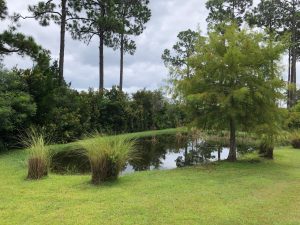
Photo courtesy: Stephen Greer, UF IFAS
Water absorption is another area to plan for, as heavy rains do occur in Florida. Having landscapes and lawns that are properly managed allow increased water infiltration into the soil is critically important. Water runoff from the site is reduced or at least slowed to allow the nutrient from fertilizers used for the plant to have more time to be absorbed into the soil and taken up by the plants. This reduces the opportunity for nitrogen, phosphorus, and other nutrients to enter water areas such as ponds, creeks, lagoons, rivers and bays. Even if you are miles from an open water source, movement of water runoff can enter ditches and work their way to these open water areas, ultimately impacting drinking water, wildlife, and unwanted aquatic plant growth.
Plan ahead and talk with experts that can help with developing a plan. Contact your local Extension office for assistance!
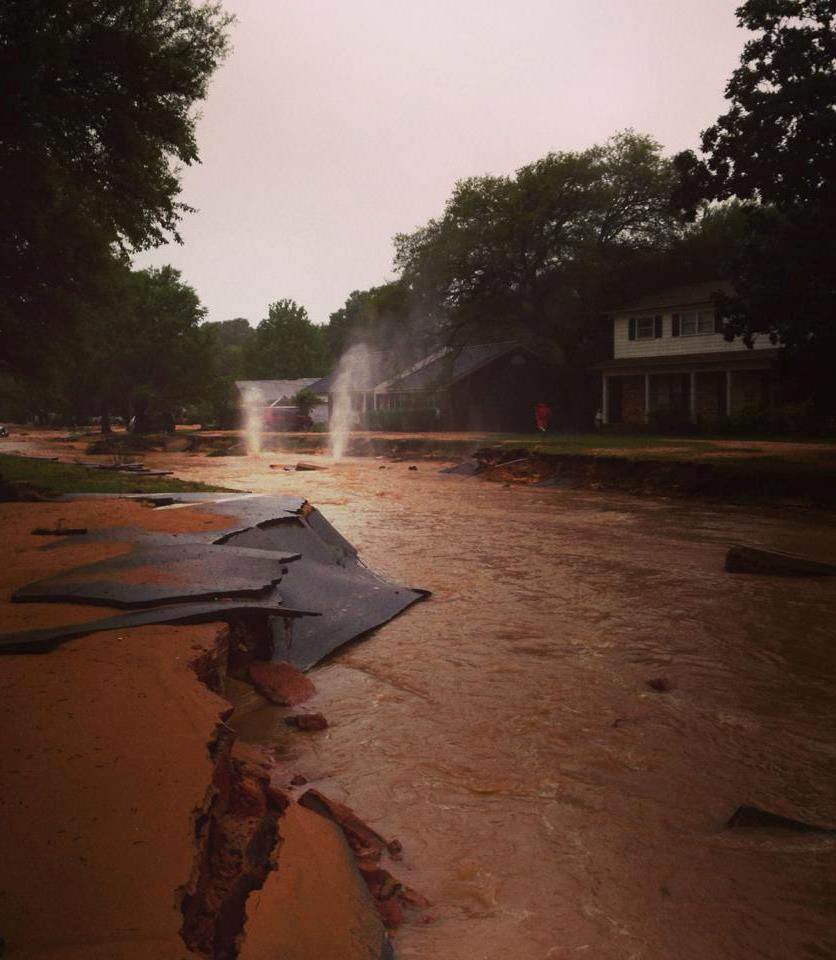
by Carrie Stevenson | May 6, 2015
Just over a year ago, southwest Alabama and northwest Florida experienced a devastating storm that left hundreds without access to their homes and businesses, flooded out and stranded by a hurricane-force storm that didn’t come with the luxury of a week’s warning. Rainfall records in Pensacola go back to 1879, and the April 29-30 storm broke them all, estimating just over 20 inches over the two days. Not only was the rainfall heavy, but the torrent was high in both velocity and volume—at one point, a mind-boggling 5.68 inches fell in the span of one hour. That’s half the annual rainfall of many cities in California and Texas!
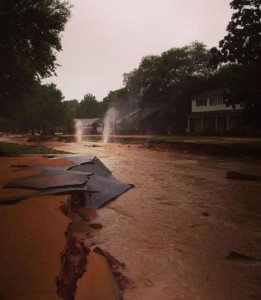
A residential street in Pensacola became a raging river a year ago during the torrential floods, putting dozens of people out of their homes. Photo credit: Carrie Stevenson UF/IFAS Extension.
With every dark storm cloud comes a silver lining, though, and just like the millions pumped into our regional economy from oil spill-related fines, the April 2014 floods have awakened a “greener” ethic among many residents, business owners, and politicians. According to a study just released by an environmental consulting firm, when asked about infrastructure changes and improvements to flooding and stormwater, attendees at community meetings overwhelmingly preferred “low impact” solutions such as expanded green space, cisterns, rain gardens, and stream restoration to “hard” structures such as bigger underground pipes and more pumps. While traditional engineering infrastructure is still crucial to a community that must maintain roads, stormwater ponds, and buildings, I find it encouraging that residents are interested in trying different techniques that have proven successful both here and in other parts of the world.
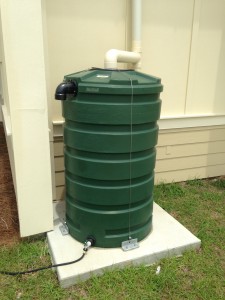
The new Langley Bell 4-H Center has four large rain barrels around the building, used to collect roof runoff for landscape design. Photo credit: Carrie Stevenson UF/IFAS Extension.
So, how does one prepare for unexpected rain and floods? The first thing is to realize that northwest Florida receives the most annual rainfall (over 60”) of any region of the state, and sometimes it seems to come down all at once. Preparing landscapes to handle both frequent and heavy rains is an important place to start. This article will begin a series of articles delving into those “low-impact” stormwater management techniques that can help lessen the impact of the intense storms we experience here in northwest Florida. Many of these practices, such as creating mulch pathways, harvesting rainwater, and installing shoreline vegetative buffers, can be implemented by individual homeowners and help reduce the impact of flooding on a neighborhood and city-wide level

by Taylor Vandiver | Apr 14, 2015
Rain gardens are an easy way to return water to our aquifer, reduce erosion, and help prevent stormwater runoff.
Running down the driveway or patio, rainwater can pick up lawn chemicals and pesticides. A rain garden is basically a low section of the landscape planted with native plants that like to get their “feet” wet. The garden collects rainwater, giving it a chance to “strain” out impurities before draining into the aquifer.

Swamp sunflower. Photo courtesy UF/IFAS.
They work best when they’re placed at the bottom of downspouts or naturally low spots in the landscape, usually where water tends to puddle. They’re especially useful for collecting runoff from paved surfaces. Rain gardens can be any size or shape and can attract thirsty wildlife.
When selecting plants, you’ll need to consider how much sun your site gets and how much space is available. Make sure you select plants that are not just water-tolerant, but also drought-tolerant for the times between rains.
Rain gardens rely on plants that will survive dry spells but then soak up excess stormwater during Florida’s rainy months, preventing the water from running across your landscape.

Blue flag iris. Photo courtesy UF/IFAS.
Include different types of plants in your rain garden to create a complete and cohesive look that will provide year-round interest. The following is a short list of flowers, shrubs, and grasses that would perform well in a rain garden.
Flowers:
- Blue flag iris
- Goldenrod
- Swamp sunflower
- Spider lily
- Milkweed
Grasses:
- Florida gamma grass
- Muhly grass
- Wiregrass
Shrubs:
- Virginia willow
- Buttonbush
- Wax myrtle
Here is a list of native plants that will do well in your North Florida rain garden. As always consult your local Extension Office for more information. All of the information in this article was provided by UF/IFAS Extension.

by Les Harrison | Jan 22, 2015

Fallen leaves add much to the landscape. They feed the plants and many insect, retain water, and help stabilize the soil
For the homeowner who feels the need to rake leaves and pine needles, the task can be something of a minor nuisance. The showers of earth-toned leftovers appear suddenly and at inconvenient times, and their removal is never added to a chore list without dispute.
Disarray aside, these organic remnants provide far more benefits than problems. Their suburban untidiness becomes an insulating blanket which nurtures plants, animals, and insects with time released nutrients for use by the efficient and fortunate in the wild and those of us in civilization.
First and foremost, leaf litter is critical to the water holding capacity of the woodlands. The dried leaves, needles and twigs absorb and shade rainwater from the evaporative effects of the sun and wind.
When heavy rains inundate the soil causing flooding and runoff, it is the leaves that act as part of the natural delaying system to minimize the negative impact on streams, creeks and rivers. The delayed or halted runoff provides time for water to be absorbed by the soil and be filtered by the natural screening capacity of this organic material.
The moisture works in conjunction with native bacteria and fungus to convert the leaf litter into nutrients usable by plants and trees. While not as concentrated as commercial fertilizers, many of the same plant nutrients are present in the decaying leaf litter.
The decomposition is aided by a variety of insects and worms which nest in, eat and overwinter under the debris. The animal activity breaks up and stirs the elements along with inoculating microbes in the matter which speeds nutrient availability to plants and trees during ideal years.
Luckily, the region’s leaf drop is spread over months with the plants and trees responding to the solar cycle and weather. Autumn, winter and spring each bring defoliation of specific trees and plants.
During dry years the bug and bacteria activity slows in accumulated leaf litter, but the naturally occurring fire cycle continues the nutrient recycling under the tree canopies. The easy to burn material aides in controlling insects and plants that can aggressively overpopulate an area if unchecked.
Controlled burns also prevent destructive wildfires which are harmful to all north Florida residents. While these uncontrolled fires do deposit nutrients, they have many negative effects which far outweigh this single benefit.
January’s weather is part of a continuing natural succession which the native plants and trees incorporate to continue the wild beauty so common in the region. The current cold and rain will combine with the leaf drop to produce much growth in the next few months.












